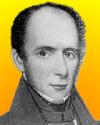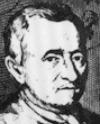 | TODAY IN SCIENCE HISTORY
NEWSLETTER - 12 JANUARY |
 On 12 Jan 1885, John Bloomfield Jervis died, an American civil engineer who became the nation's leading consulting engineer of his time. In the period (1830-60) before the Civil War, he worked on several significant canal projects, railroads and water-supply systems. In his era, the development of infrastructure was extremely important to industrial growth in America. Jervis began in his early twenties on the construction of the Erie Canal, and quickly progressed from axman, to rodman and Resident Engineer at age about 25. By the time he died, at age 89, he had many great engineering achievements, which you can read in John Bloomfield Jervis, his obituary in the Proceedings of the American Society of Civil Engineers (1885) On 12 Jan 1885, John Bloomfield Jervis died, an American civil engineer who became the nation's leading consulting engineer of his time. In the period (1830-60) before the Civil War, he worked on several significant canal projects, railroads and water-supply systems. In his era, the development of infrastructure was extremely important to industrial growth in America. Jervis began in his early twenties on the construction of the Erie Canal, and quickly progressed from axman, to rodman and Resident Engineer at age about 25. By the time he died, at age 89, he had many great engineering achievements, which you can read in John Bloomfield Jervis, his obituary in the Proceedings of the American Society of Civil Engineers (1885) |
 On 12 Jan 1907, Sergey Korolev was born, Soviet designer of guided missiles, rockets and spacecraft. In 1933, he particpated in the lauch of the first Soviet rocket. Thereafter, he directed the design, construction, testing and launch of most of the Soviet's space projects. Around 1958, he promoted the idea of manned space flight. Today's Science Store pick is: The First Space Race: Launching the World's First Satellites (Centennial of Flight Series), by Matthew A. Bille, Erika Lishock, which includes a chapter on “The Dream of Sergey Korolev” among other references to his contribution to leading the Soviet Union into space. In addition to outlining the Soviet effort which was once so secret that few even knew it existed, the authors reveal how challenging the first steps into space really were for the American teams. The authors’ focus on the rivalries in the first satellite race makes a compelling read. It is available New from $10.96. Used from $4.20. (As of time of writing.). On 12 Jan 1907, Sergey Korolev was born, Soviet designer of guided missiles, rockets and spacecraft. In 1933, he particpated in the lauch of the first Soviet rocket. Thereafter, he directed the design, construction, testing and launch of most of the Soviet's space projects. Around 1958, he promoted the idea of manned space flight. Today's Science Store pick is: The First Space Race: Launching the World's First Satellites (Centennial of Flight Series), by Matthew A. Bille, Erika Lishock, which includes a chapter on “The Dream of Sergey Korolev” among other references to his contribution to leading the Soviet Union into space. In addition to outlining the Soviet effort which was once so secret that few even knew it existed, the authors reveal how challenging the first steps into space really were for the American teams. The authors’ focus on the rivalries in the first satellite race makes a compelling read. It is available New from $10.96. Used from $4.20. (As of time of writing.). | | For picks from earlier newsletters, see the Today in Science History Science Store home page. | |
 | I call this Spirit, unknown hitherto, by the new name of Gas, which can neither be constrained by Vessels, nor reduced into a visible body, unless the feed being first extinguished. But Bodies do contain this Spirit, and do sometimes wholly depart into such a Spirit, not indeed, because it is actually in those very bodies (for truly it could not be detained, yea the whole composed body should I lie away at once) but it is a Spirit grown together, coagulated after the manner of a body, and is stirred up by an attained ferment, as in Wine, the juyce of unripe Grapes, bread, hydromel or water and Honey. - Jan Baptista van Helmont, Belgian natural philosopher, chemist, physician and physiologist (born 12 Jan 1579).  |
 | The operating management, providing as it does for the care of near thirty thousand miles of railway, is far more important than that for construction in which there is comparatively little doing. - John B. Jervis, American civil engineer (died 12 Jan 1885).  |
 | [Et peut-�tre la posterit� me saura gr� de lui avoir fait conna�tre que les Anciens n�ont pas tout su.]
And perhaps, posterity will thank me for having shown that the ancients did not know everything. - Pierre de Fermat, French mathematician (died 12 Jan 1665).  |
| Before you look at today's web page, see if you can answer some of these questions about the events that happened on this day. Some of the names are very familiar. Others will likely stump you. Tickle your curiosity with these questions, then check your answers on today's web page. |
 | On 12 Jan 1916, Ruth Benerito was born. She was an American chemist whose pioneering research produced a major development for fabrics made by the textile industry. The result is known by an every-day term.
 What was the development this scientist gave to the textiles now in everyday use? |
 | On 12 Jan 1580, Jan Baptista van Helmont was born, who recognized the existence of discrete gases. He determined that the gas given off by burning charcoal is the same as that given off by fermenting grape juice. He called it spiritus silvestre (“wild spirit”).
 By what name is this "wild spirit" gas now known? |
 | Pierre Fermat (1601-1665) was a French mathematician who died leaving an enigmatic reference to his solution of a theorem, but without the full explanation. For centuries, others attempted to recreate a proof to his simply written extension to the Pythagorean theorem.
 What was Fermat's extension to the Pythagorean theorem? |
 | John Bloomfield Jervis (1795-1885), was the American civil engineer who designed the first locomotive to run in America. He had it built in Britain to run on the railroad he incorporated into the Delaware and Hudson Canal project, at a time there were no railroads in America.
 What was the name of the first American railroad locomotive that Jervis designed? |
| On 12 Jan in different years, various patents were issued to the same American inventor. These included: “Electrode for Telephone-Transmitters” (1886), “Waterproofing Paint for Portland Cement Buildings” (1909), and “Method and Means for Improving the Rendition of Musical Compositions” (1919).
 Which inventor held these patents? |
| On 12 Jan 1908, a wireless message was sent long-distance for the first time from a European structure selected for this purpose because of its height.
 What was this structure? |
When you have your answers ready to all the questions above, you'll find all the information to check them, and more, on the January 12 web page of Today in Science History. Or, try this link first for just the brief answers.
Fast answers for the previous newsletter for January 11: decade including the year 1934 • fruit fly • cosmic rays • CERN • cigarette smoking linked to lung cancer • Titania. |
 If you enjoy this newsletter, the website, or wish to offer encouragement or ideas, please send feedback by using your mail reader Reply button. If you enjoy this newsletter, the website, or wish to offer encouragement or ideas, please send feedback by using your mail reader Reply button.
Your click on a StumbleUpon, Google+ or Facebook social button on the site webpages is also a welcome sign of appreciation. Thank you for using them. |
To find citations for quotations go to the corresponding webpage by clicking on the “quotes” balloon icon. Sources for the thumbnails appear on today's webpage with the corresponding item.
� This newsletter is copyright 2014 by todayinsci.com. Please respect the Webmaster's wishes and do not put copies online of the Newsletter � or any Today in Science History webpage. (If you already have done so, please remove them. Thank you.) Offline use in education is encouraged such as a printout on a bulletin board, or projected for classroom viewing. Online, descriptive links to our pages are welcomed, as these will provide a reader with the most recent revisions, additions and/or corrections of a webpage. For any other copyright questions, please contact the Webmaster by using your mail reader Reply button. |
--
If you do not want to receive any more newsletters,
Unsubscribe To update your preferences and to unsubscribe visit
this link 


 On 12 Jan 1885, John Bloomfield Jervis died, an American civil engineer who became the nation's leading consulting engineer of his time. In the period (1830-60) before the Civil War, he worked on several significant canal projects, railroads and water-supply systems. In his era, the development of infrastructure was extremely important to industrial growth in America. Jervis began in his early twenties on the construction of the Erie Canal, and quickly progressed from axman, to rodman and Resident Engineer at age about 25. By the time he died, at age 89, he had many great engineering achievements, which you can read in John Bloomfield Jervis, his obituary in the Proceedings of the American Society of Civil Engineers (1885)
On 12 Jan 1885, John Bloomfield Jervis died, an American civil engineer who became the nation's leading consulting engineer of his time. In the period (1830-60) before the Civil War, he worked on several significant canal projects, railroads and water-supply systems. In his era, the development of infrastructure was extremely important to industrial growth in America. Jervis began in his early twenties on the construction of the Erie Canal, and quickly progressed from axman, to rodman and Resident Engineer at age about 25. By the time he died, at age 89, he had many great engineering achievements, which you can read in John Bloomfield Jervis, his obituary in the Proceedings of the American Society of Civil Engineers (1885) 



 What was the development this scientist gave to the textiles now in everyday use?
What was the development this scientist gave to the textiles now in everyday use? 
 By what name is this "wild spirit" gas now known?
By what name is this "wild spirit" gas now known? 
 What was Fermat's extension to the Pythagorean theorem?
What was Fermat's extension to the Pythagorean theorem? 
 What was the name of the first American railroad locomotive that Jervis designed?
What was the name of the first American railroad locomotive that Jervis designed?  Which inventor held these patents?
Which inventor held these patents?  What was this structure?
What was this structure?  If you enjoy this newsletter, the website, or wish to offer encouragement or ideas, please send feedback by using your mail reader Reply button.
If you enjoy this newsletter, the website, or wish to offer encouragement or ideas, please send feedback by using your mail reader Reply button. 

Δεν υπάρχουν σχόλια:
Δημοσίευση σχολίου